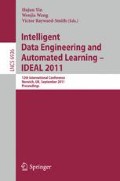Abstract
Calculating the similarity of predictive models helps to characterize the models diversity and to identify relevant models from a collection of models. The relevant models are considered based on their performance, calculated using their confusion matrix. In this paper, we propose a methodology to measure the similarity for predictive models performances by comparing their confusion matrices. In this research, we focus on multi-class classifiers for toxicology applications. The performance measures of confusion matrices of multi-class classifiers are regrouped into a binary classification problem. Such approach may result in selecting multi-class classifiers with lower False Negative Rate (FNR) for example. Consequently, the methodology for model comparison based on the similarity of confusion matrices provides a working way to select models from a collection of classifiers.
Access this chapter
Tax calculation will be finalised at checkout
Purchases are for personal use only
Preview
Unable to display preview. Download preview PDF.
References
Makhtar, M., Neagu, D.C., Ridley, M.J.: Binary classification models comparison: On the similarity of datasets and confusion matrix for predictive toxicology applications. In: Khuri, S., Lhotská, L., Pisanti, N. (eds.) ITBAM 2011. LNCS, vol. 6865, pp. 108–122. Springer, Heidelberg (2011)
Galar, M., Fernández, A., Barrenechea, E., Bustince, H., Herrera, F.: An overview of ensemble methods for binary classifiers in multi-class problems: Experimental study on one-vs-one and one-vs-all schemes. J. Pattern Recognition 44, 1761–1776 (2011)
Kohavi, R., Provost, F.: Glossary of Terms. Editorial for the Special Issue on Applications of Machine Learning and the Knowledge Discovery Process. J. Machine Learning 30, 271–274 (1998)
Fawcett, T.: ROC Graphs: Notes and Practical Considerations for Researchers. HP Laboratories, http://www.hpl.hp.com/techreports/2003/HPL-2003-4.pdf
Prasanna, S.R.M., Yegnanarayana, B., Pinto, J.P., Hermansky, H.: Analysis of Confusion Matrix to Combine Evidence for Phoneme Recognition. IDIAP Research Report, IDIAP-RR-27-2007 (2007)
Freitas, C.O.A., Carvalho, J.M.D., Jose Josemar Oliveira, J., Aires, S.B.K., Sabourin, R.: Confusion Matrix Disagreement for Multiple Classifiers. In: Proceedings Of The Congress On Pattern Recognition 12th Iberoamerican Conference on Progress in Pattern Recognition, Image Analysis and Applications, pp. 387–396 (2007)
Witten, I.H., Frank, E., Trigg, L., Hall, M., Holmes, G., Cunningham, S.J.: Weka: Practical Machine Learning Tools and Techniques with Java Implementations. In: Proceedings of the ICONIP/ANZIIS/ANNES 1999 Workshop on Emerging Knowledge Engineering and Connectionist-Based Information Systems, pp. 192–196 (1999)
DEMETRA Project, http://www.demetra-tox.net/
Neagu, D., Guo, G.: A Data-Driven Approach for Improved Effective Classification in Predictive Toxicology. In: Proceeding of IEEE International Conference on Computational Cybernetics ICCC 2006, pp. 193–198 (2006)
Trundle, P.: Hybrid Intelligent Systems Applied to Predict Pesticides Toxicity - a Data Integration Approach. PhD Thesis. School of Informatics. University of Bradford, UK (2008)
Author information
Authors and Affiliations
Editor information
Editors and Affiliations
Rights and permissions
Copyright information
© 2011 Springer-Verlag Berlin Heidelberg
About this paper
Cite this paper
Makhtar, M., Neagu, D.C., Ridley, M.J. (2011). Comparing Multi-class Classifiers: On the Similarity of Confusion Matrices for Predictive Toxicology Applications. In: Yin, H., Wang, W., Rayward-Smith, V. (eds) Intelligent Data Engineering and Automated Learning - IDEAL 2011. IDEAL 2011. Lecture Notes in Computer Science, vol 6936. Springer, Berlin, Heidelberg. https://doi.org/10.1007/978-3-642-23878-9_31
Download citation
DOI: https://doi.org/10.1007/978-3-642-23878-9_31
Publisher Name: Springer, Berlin, Heidelberg
Print ISBN: 978-3-642-23877-2
Online ISBN: 978-3-642-23878-9
eBook Packages: Computer ScienceComputer Science (R0)

